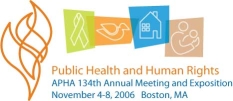 Back to Annual Meeting
|

|
 Back to Annual Meeting
|
APHA Scientific Session and Event Listing |
 Back to Annual Meeting
|

|
 Back to Annual Meeting
|
APHA Scientific Session and Event Listing |
Janette Baird, PhD1, Michael J. Mello, MD, MPH2, Ted D. Nirenberg, PhD2, Richard Longabaugh, EdD3, and Robert Woolard, MD4. (1) Injury Prevention Center, 110 Lockwood Street, Room 334, Providence, RI 02903, 401 444-2685, jbaird@lifespan.org, (2) Injury Prevention Center, Rhode Island Hospital, 110 Lockwood Street, Suite 334, Providence, RI 02903, (3) Center for Alcohol and Addiction Studies, Brown University, Box G-BH, Brown University, Providence, RI 02912, (4) Emergency Medicine, Rhode Island Hospital, 593 Eddy Street, Providence, RI 02874
Objective: Risky behaviors (alcohol, seatbelt, marijuana use) have been associated with injury and targeted interventions to decrease future injuries. We compare the prevalence of these behaviors among medically ill ED pts to injured ED pts to determine if this was also a suitable group for injury reduction interventions. Method: An anonymous self-administered 12-item general health questionnaire including alcohol, marijuana and seatbelt use was given to non-critical ED pts sampled from pre-selected shifts from all days of the week over a 6-month period. This questionnaire was used as a prescreening instrument for a targeted substance abuse intervention. These data are on pts not recruited into the intervention study. Results: 2,755 ED pts (60% ill/40% injured) were screened. Females were more likely to report illness as the reason for the ED visit than males ( p<.001). Using the NIAAA guidelines for harmful and hazardous alcohol use (males: > 14 standard drinks per week; females: > 7 standard drinks per week) we found that 64% of female harmful drinkers were from the ill group (p = .02). The distribution of male harmful drinkers did not significantly vary between the ill (49%) and injured groups. There was no difference in passenger/driver seatbelt use rates between ill or injured ED pts. Conclusions: These data demonstrate that several of the risky behaviors associated with injuries are as likely to be reported by ill patients. This information indicates that ED interventions designed to target the high-risk behaviors for injury could also be offered to ill patients.
Learning Objectives: At the conclusion of the session, the participant (learner) in this session will be able to
Keywords: Risky Behaviors, Emergency Department/Room
Presenting author's disclosure statement:
Not Answered
The 134th Annual Meeting & Exposition (November 4-8, 2006) of APHA